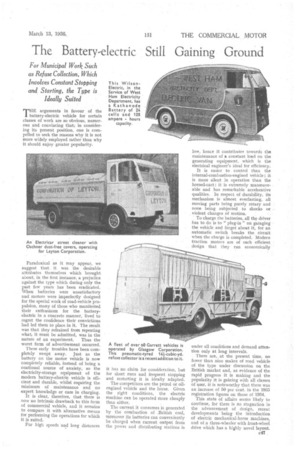The Battery-electric Still Gaining Ground
Page 99

If you've noticed an error in this article please click here to report it so we can fix it.
For Municipal Work Such as Refuse Collection, Which Involves Constant Stopping and Starting, the Type is Ideally Suited
THE arguments in favour of the battery-electric vehicle for certain classes of work are so obvious, numerous and convincing that in considering its present position, one is compelled to seek the reasons why it is not more widely employed rather than why it should enjoy greater popularity.
Paradoxical as it may appear, we suggest that it was the desirable attributes themselves which brought about, in the first instance, a prejudice against the type which during only the past few years has been eradicated. When batteries were unsatisfactory and motors were imperfectly designed for the special work of road-vehicle propulsion, many of those who manifested their enthusiasm for the batteryelectric in a concrete manner, lived to regret the confidence their convictions had led them to place in it. The result was that they refrained from repeating what, it must be admitted, was in the nature of an experiment. Thus the worst form of advertisement occurred.
These early troubles have been completely swept away. Just as the battery on the motor vehicle is now completely reliable, instead of being a continual source of anxiety, so the electricity-storage ,equipment of the modem battery-electric vehicle is efficient and durable, whilst requiring the minimum of maintenance and no expert knowledge or care in charging. It is clear, therefore, that there is now no intrinsic drawback to this form of commercial vehicle, and it remains to compare it with alternative means for performing the operations for which it is suited.
For high speeds and long distances it has no claim for consideration, but for short runs and frequent stopping and restarting it is ideally adapted.
The competitors are the petrol or oilengined vehicle and the horse. Given the right conditions, the electric machine can be operated more cheaply than either.
The current it consumes is generated by the combustion of .British coal, moreover its batteries can conveniently be charged when current output from the power and distributing stations is low, hence it contributes towards the maintenance of a constant load on the generating equipment, which is the electrical engineer's ideal for efficiency.
It is easier to control than the internal-combustion-engined vehicle ; it is more silent in operation than the horsed-cart; it is extremely manceuvrable and has remarkable accelerative qualities. In respect of durability, its mechanism is almost everlasting, all moving parts being purely rotary and none being subjected to shocks or • violent changes of motion.
To charge the batteries, all the driver has to do is to "plug-in" on garaging the vehicle and forget about it, for an automatic switch breaks the circuit when the charge is completed. Modern traction motors are of such efficient design that they run economically under all conditions and demand attention only at long intervals.
• There are, at the present time, no• fewer than nine makes of road vehicle of the type under discussion on the British market and, as evidence of the rapid progress it is making and the popularity it is gaining with all classes of user, it is noteworthy that there was an increase of 50 per cent. in the 1935 registration figures on those of 1934.
This state of affairs seems likely to continue, for there is no stagnation in the advancement of design, recent developments being the introduction of electric mechanical-horse machines, and of a three-wheeler with front-wheel drive which has a highly novel layout.


























































































































































